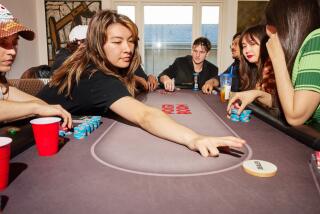Pre-flop boldness pays off
- Share via
The evolving aggressive style of poker played in many tournaments over the last couple of years has led to a lot of big bets with drawing hands, most notably A-K, A-Q and even K-Q.
“I don’t disagree with limping with K-Q suited,” said Swedish pro Martin de Knijff. “The hand has some equity, but I think people raise way too much before the flop with that and other hands where if someone re-raises, they really can’t call. They do call. But they shouldn’t.”
Taking advantage of that kind of mistake is what the game is all about, as De Knijff did in 2008 during the $25,000-buy-in World Poker Tour Championship at Las Vegas’ Bellagio.
With blinds at $1,500-$3,000, plus a $400 ante, the player under the gun limped. Next to act, De Knijff drew A-K offsuit and raised to $15,000.
“I had a lot of players behind me, and if someone decides to call, I’m going to narrow the kind of hands they would play,” said De Knijff, winner of the 2004 WPT Championship. “They wouldn’t call with 10-9, say, for $15,000. It allows me to play the hand easier after the flop.”
Action folded back to the player to De Knijff’s right.
“He has about $100,000,” De Knijff said. “So I’m thinking that if he slow-played something, he’s going to check-raise me. But when he flat-called, I put him on a medium pair like 9s.”
The flop came A-Q-5, rainbow, giving De Knijff top pair/top kicker. His opponent bet out $30,000.
“I wasn’t sure if I was going to call here or move in,” De Knijff said. “If I just call, he’s going to continue to fire and I get all his chips in. If I move in, I might lose him. That was my dilemma.”
De Knijff made it simple by moving all in. His opponent had him covered, but not by a lot. He called with K-Q of diamonds.
“And I don’t know why,” De Knijff said. “If he fires on the flop, he hopes I have two kings and I’ll lay it down with the ace out there. With K-Q of diamonds, he wants to see a flop and he’s reasonably deep-stacked. But if somebody comes in for a raise, he can’t call.”
And yet, people will overplay K-Q that way, happily so for De Knijff, who took the pot when the rest of the board came the 7 of hearts and the king of spades.
“When you have A-K in tournaments, you want to be the guy who pushed,” De Knijff said. “If you raise and someone re-raises, now you can push all in. It’s very unlikely that you’re going to be up against aces or kings, and even if you’re up against kings, you still have your 30% of hitting an ace. I like to play the hand very aggressively before the flop because it helps define the other players’ hands.”
Table talk
Slow-playing: To passively play a strong hand in hopes of inducing opponents to overplay lesser holdings.


